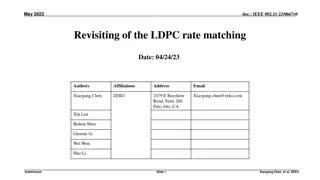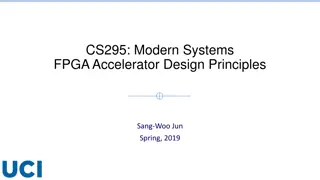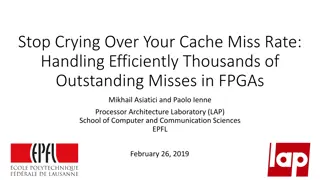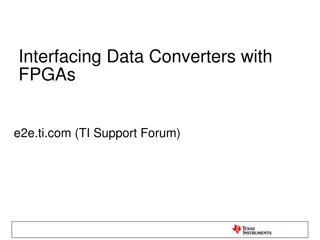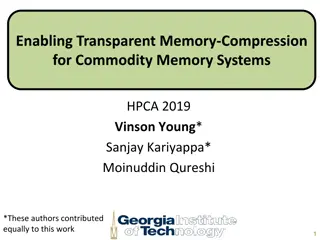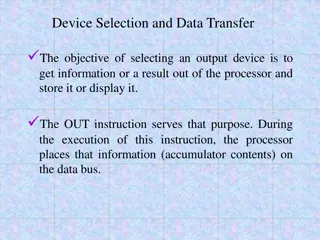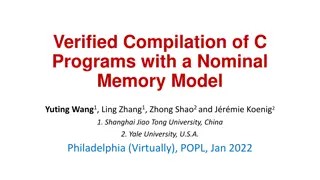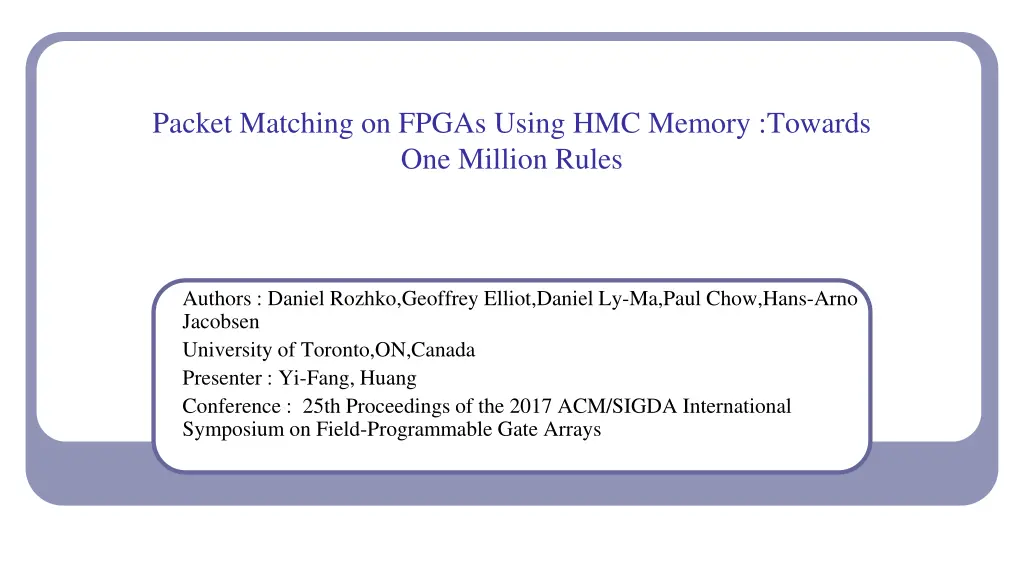
Implementing Packet Matching on FPGAs Using HMC Memory
Explore the implementation of packet matching on Field-Programmable Gate Arrays (FPGAs) using Hybrid Memory Cube (HMC) technology towards managing one million rules efficiently. Learn about the challenges in networking infrastructure, utilizing HMC-based memories for improved performance, and the complete system architecture involved.
Download Presentation

Please find below an Image/Link to download the presentation.
The content on the website is provided AS IS for your information and personal use only. It may not be sold, licensed, or shared on other websites without obtaining consent from the author. If you encounter any issues during the download, it is possible that the publisher has removed the file from their server.
You are allowed to download the files provided on this website for personal or commercial use, subject to the condition that they are used lawfully. All files are the property of their respective owners.
The content on the website is provided AS IS for your information and personal use only. It may not be sold, licensed, or shared on other websites without obtaining consent from the author.
E N D
Presentation Transcript
Packet Matching on FPGAs Using HMC Memory :Towards One Million Rules Authors : Daniel Rozhko,Geoffrey Elliot,Daniel Ly-Ma,Paul Chow,Hans-Arno Jacobsen University of Toronto,ON,Canada Presenter : Yi-Fang, Huang Conference : 25th Proceedings of the 2017 ACM/SIGDA International Symposium on Field-Programmable Gate Arrays
Outline Introduction Implementation Evaluation National Cheng Kung University CSIE Computer & Internet Architecture Lab 2
Introduction FPGAs with their reconfigurable nature and high bandwidth interfaces represent a logical choice for networking infrastructure. However, their limited memory restricts the amount of information that can be stored within the chip, and off-chip memories are typically too slow to meet the demands of high-speed networks. Hybrid Memory Cube (HMC) based memories present one avenue to alleviate this bottleneck. At a high level, an HMC module consists of stacks of DRAM memory connected vertically by through silicon vias (TSVs) . National Cheng Kung University CSIE Computer & Internet Architecture Lab 3
Complete system architecture National Cheng Kung University CSIE Computer & Internet Architecture Lab 4
HW and Development Framework The system was designed to use a Micron AC-510 FPGA accelerator card, which features 4GB of HMC connected over two 8-lane SerDes links to a Xilinx Kintex Ultrascale 060 FPGA As part of the infrastructure to support the AC-510 and HMC, Micron provides the Pico Framework , a wrapper for the FPGA to include the PCIe and HMC links in hardware designs , as well as software libraries and drivers for the host CPU. These libraries allow for simple software development and a simple protocol for communicating between the host and the FPGA/HMC. National Cheng Kung University CSIE Computer & Internet Architecture Lab 5
Test Packet Generator The Micron AC-510 Board was chosen for its HMC memory module, but it lacks the network interface that would allow our system to be tested in a real network deployment. Instead, our architecture was tested with a spoofed network interface: packets were generated and results verified onchip. The Test Packet Generator creates and sends a continuous stream of packets at a line rate of up to 10 Gbps. Rather than generate random packets on-chip, this component holds a group of pre-generated packets in on-chip memory and sends them in an infinite loop. The random packets themselves are generated in software and streamed to the test framework at initialization time through the Pico Framework. Note, since the random packets are generated in software, the expected match results can also be computed in software and sent to the system at initialization time National Cheng Kung University CSIE Computer & Internet Architecture Lab 6
Packet Header Extractor The Packet Header Extractor parses the Ethernet stream and separates the packet header bits into their corresponding fields , to be processed by the Packet Matching Engine. Note, this component also tags each packet with an ingress timestamp (from a global counter), for the calculation of packet latency. Openflow1.1.0 match fields National Cheng Kung University CSIE Computer & Internet Architecture Lab 7
Output Result Verifier Finally, the Output Result Verifier receives the match results from the Matching Engine and verifies that the correct match was made. These correct matches are computed in software and streamed to the component at initialization time to be stored in on-chip memory. The verifier streams the number of errors and some statistics back to the host on a packet-batch basis (i.e. one iteration of the packet infinite loop). The statistics include the average packet latency for the batch (calculated using the global counter and packet timestamp), the total counter cycles taken for the batch (to calculate throughput), and the total number of rule fetch cycles taken for the batch (to calculate memory bandwidth). National Cheng Kung University CSIE Computer & Internet Architecture Lab 8
Outline Introduction Implementation Evaluation National Cheng Kung University CSIE Computer & Internet Architecture Lab 9
HMC Memory Prefetcher the FPGA fabric has ten ports with which to access the HMC. The vendor-provided framework reserves one port for host access, leaving nine ports for use by the prefetcher. To simplify the request logic, the prefetcher distributes requests over eight of the nine ports. each of the eight HMC ports is connected to an individual prefetching unit. Each unit issues 128- byte (2-rule) requests from the HMC in a sequential order to minimize the response time. Note: (Bus width = 8(HMC ports number )*128byte=1KB) National Cheng Kung University CSIE Computer & Internet Architecture Lab 10
HMC Memory Prefetcher Each response is returned in eight 16-byte segments, which are collected and split into the two rules. Each unit feeds these rules into an arbiter multiplexer, which coalesces the eight streams into one. Once all the rules have been retrieved (based on the value of the global RuleCount register at the start of a cycle), the prefetcher then issues requests for up to 1/4 of the rules prior to the start of another match cycle. This minimizes the downtime of the HMC link, but does limit alterations to the ruleset namely, that the ruleset cannot shrink by more than 75% on a given matching cycle. National Cheng Kung University CSIE Computer & Internet Architecture Lab 11
Packet Matching Engine The packet matching engine compares the headers of incoming packets against a ruleset and outputs the action of the highest priority matching rule. Rules and packet headers are streamed in from two FIFOs that are populated by the Packet Header Extractor and Memory Prefetcher circuits respectively. The processing engine (PE) compares all the fields in the packet with the fields of each rule. The outputs of these comparisons are logically ANDed together to check if all fields of a particular rule have been matched. Exact match fields will output true(1) if the mask bit is low(0). Internal registers keep track of the highest priority rule and its corresponding action. Each new matching rule s priority is compared against the current highest priority and if the priority of the new rule is higher, these registers will take on the values of the new rule. National Cheng Kung University CSIE Computer & Internet Architecture Lab 12
Systolic matching engine Architecture Since rules are read in sequentially, having more PEs will allow for more packets to be processed in parallel, thus increasing the throughput. However, we discovered that this architecture did not scale well with the number of PEs as it was difficult to meet timing for more than 100 PEs. This was due to the increasingly large fanout of the Rule Stream data signal and the deepening of the LUT levels required for the multiplexer and demultiplexer logic as the number of PEs increased. Our second architecture, tries to overcome these shortcomings. First, the PEs are placed in a systolic array architecture to reduce the fanout of the Rule Stream data signal and remove the need for the large multiplexer and demultiplexer. Packet headers in the FIFO are sequentially shifted through the array until either the FIFO is empty or the array is full. National Cheng Kung University CSIE Computer & Internet Architecture Lab 13
Systolic matching engine Architecture The PEs load the header into their internal registers and rules are then sequentially shifted through the array for each PE to compare against its header. Once all the rules have been shifted through, the output of the PEs are loaded into a parallel shift register and then shifted into the output FIFO. These optimizations allowed us to pack 60% more PEs (160 in total) into the matching engine. National Cheng Kung University CSIE Computer & Internet Architecture Lab 14
Outline Introduction Implementation Evaluation National Cheng Kung University CSIE Computer & Internet Architecture Lab 15
Packet Throughput & Processing Latency Two entries in the table correspond to our work: the system tested with 1504 rules (max rule count at 10 Gbps) and 2^20= 1048576 rules, as the first and second entries respectively. We note that previous systems outperform our implementation at lower rule counts; this is expected, since these systems utilize only on-chip memory. Our off- chip memory solution is the only hardware system (to the best of our knowledge) that can support much larger rule counts, achieving a processing rate of 16.4 Mbps at 1M rules. National Cheng Kung University CSIE Computer & Internet Architecture Lab 16
Resource Utilization National Cheng Kung University CSIE Computer & Internet Architecture Lab 17

